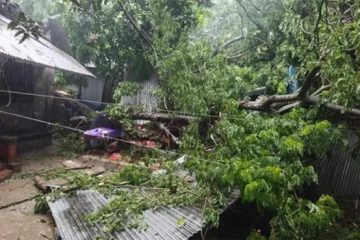Country forks out Tk 300cr a year on fixing damaged roads
 Almost all the 40,000 trucks running throughout the country carry weights more than twice the capacity, causing colossal damage to the roads and bridges.
Almost all the 40,000 trucks running throughout the country carry weights more than twice the capacity, causing colossal damage to the roads and bridges.
Sources at the Roads and Highways Department (RHD) said the trucks bring about severe traffic congestion, pollution and lead to loss of lives as well.
A ‘Road master plan study’ conducted in 2007 by WSP, a United Kingdom-based consulting firm, says overloaded trucks lead roads to wear and tear before their projected deterioration, costing the country around Tk 300 crore each year in additional maintenance need.
According to sources at the Bangladesh Road Transport Authority (BRTA), RHD, and Transport Owners and Workers Association, each five-tonne and seven-tonne truck carries up to 15 to 20 tonnes of freight. Experts said such feckless overloading of trucks not only damages the roads but also leads to breakdown, traffic congestion and life threatening accidents.
During monsoon, serious traffic gridlocks build up when overloaded vehicles do not want to descend on the hard shoulders of highway for fear of getting stuck on soil. Traffic congestions build up for hours every day when two such overloaded vehicles try to pass each other.
An expert of RHD said, “Regulations have to be enforced to ensure that vehicles are not physically modified from the registered specifications. The axle loads of trucks also need to be controlled to protect the road networks from severe damage.” The axle load is the maximum weight of a truck per pair of wheels allowable for a given section of road.
According to Rafiqul Islam, manager (operations) of BRTA, the heavy eight-wheelers are permitted to carry a total of eight tonnes of freight apart from the vehicle’s own weight. The front two wheels are allowed to carry a weight of 5.5 tonnes while the rear four are permitted to carry 10 tonnes.
However, the lorries tend to carry up to 20 to 25 tonnes of weight, which is more than twice its capacity.
An expert on highway engineering at RHD told The Daily Star on condition of anonymity that the highways are built with the calculation of ‘equivalent standard axle load’ of 8.4 tonnes, considered as a single unit. The roads are damaged when two-axle vehicles pass on it carrying multiple such units.
According to the expert, the weight of the vehicle and the load are not evenly distributed due to overloading. He suggested that the government should introduce multi-axle trailers that can carry large amount of cargo without causing much damage to the roads.
There are two axle load control stations in the country that are supposed to monitor the axle-load of vehicles and take appropriate actions in case of violations. However, both these stations are allegedly ridden with anomalies and irregularities, and have done little to bring any regularity in this regard.
Experts suggested introduction of more axle load control stations along with proper enforcement of the existing laws to improve the situation.
Sources said the trend of overloading vehicles started with the import of heavy Japanese and Indian trucks during the early 90s. Weight limit for those trucks was fixed at 11 tonnes including the weight of the truck. But when drivers realised their vehicles could carry as much as 20 tonnes of goods, they started to ignore the restrictions violating the national norm for roads.
Bangladesh Truck Drivers Association former chairman Monirul Islam however blamed consignees for insisting upon overloading the vehicles.
Truck owners say most of the time they are not aware of the amount of load their lorries are carrying in their countrywide tours, adding that they are paying the police more for overloading.
“Truck drivers know they are breaking the law. So they do not hesitate to bribe the police. After getting money, police are also happy to overlook the overloading,” said Rustam Ali Khan, general secretary of Bangladesh Truck-Coveredvan Owners’ Association.




















